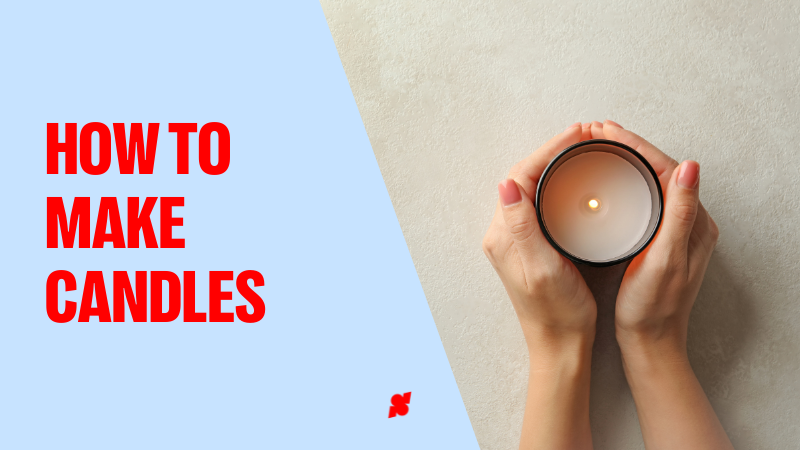
What is user-generated content? How can it help me boost my social media presence? Keep reading to check out some user-generated content examples and some extra tips to make this strategy work for your online store.
User-generated content: table of contents
- What is user-generated content?
- Why is UGC good for business?
- Some examples of user-generated content
- How to encourage customers to create UGC?
- Some tips for collecting and sharing user-generated content
Starting an online store involves managing a lot of different things. There’s the financial side, with profit margins and ROI, but there’s also shipping, website design, marketing campaigns, pricing strategies, customer service… The list goes and on.
However, there are two aspects of any online business that demand some love and care: Creating content for social media channels and building trust among followers and potential customers.
Honestly, it’s no wonder these two areas demand special attention. In the age of social commerce, it’s practically impossible for an ecommerce brand not to have a social media presence. The same applies when we’re talking about building trust: When people really want to know more about a brand, they go to the store’s social media profiles and scroll through comments and photos.
The thing is, managing social media channels is no small feat. You have to maintain a certain posting schedule, and you also need to come up with content ideas. Then there’s picking the type of media (photos, videos, gifs…) and, of course, the captions and text that accompany the post itself.
And you also need to decide which platforms you’ll post on: Facebook? Instagram? TikTok? YouTube? Twitter?
It’s a humongous task, right? So wouldn’t it be awesome if you could just harvest some ready-made content from your social media users? Preferably, from users that love your brand and that posted pictures and created videos of your products?
That’s what user-generated content, or UGC, is for.
🤓 Want to know a bit more about starting a business? Check out our recommended reads:
- 20 Ways to Make Money from Home in Canada in 2023
- What is Market Research: Definition, Examples and How to Do It
- Product Development: A Guide to Help You Create Your Own Product
What is user-generated content?
User-generated content is a big name, but it’s actually pretty self-explanatory: It refers to any type of content created by users about a specific brand.
While the most common example of user-generated content involves social media posts, like an Instagram Story, a TikTok video or a comment left by a follower on a brand’s post, UGC actually encompasses a whole lot of different user content.
In fact, you can think about user-generated content as a synonym for “consumer-generated content”―because practically any type of comment made by a consumer about your brand can be understood (and used) as UCG.
Why is UGC good for business?
The short answer to that is: Because consumers trust content created by people who are just like them.
Makes sense, right? After all, paid traffic strategies might up your chances of getting a target audience in front of your content, be it a shoppable Instagram post or a product page on your online store. But just getting them there doesn’t necessarily mean that they’ll make a purchase.
That’s when user-generated content steps in. When someone who’s not familiar with your brand first comes into contact with it, be it on social media or on your website, it’s highly likely that that person will start searching for proof that the brand can be trusted.
If they’re on social media platforms, they’ll scroll through your posts to see how the brand acknowledges and treats their customers. And if they’re on the store’s website, they’ll probably look for customer reviews about the product they intend to buy.
Having a solid UCG strategy in place can help your brand on different fronts, as you’ll see below.
1. Helps you grow organically
Expanding a business is tough, no matter your current size. First-time entrepreneurs usually struggle with getting their businesses off the ground, while for small and medium-sized shops, the challenge lies in expanding sustainably and acquiring more followers.
While organic growth is hard, it’s also something you cannot do without―especially because nobody’s got the money to keep growing on paid advertising alone.
Relying on user-generated content for this can be a great strategy to counter your ad spending. For instance, you can encourage users to tag your profile whenever they post something about the brand on social media, and then repost that content on your official accounts.
This will help social platforms put your account in front of people who might not be familiar with your brand, even though they’re part of your target audience. We’re thinking, for instance, of those friends and followers of the person who created the content you’re reposting.
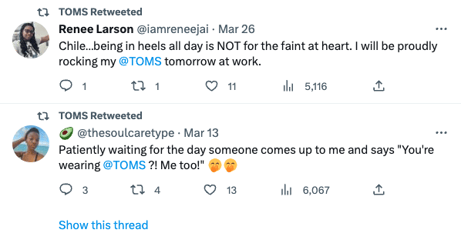
TOMS’ official Twitter account is an incredible example of user-generated content. The brand is always retweeting users that happened to tag the brand, which allows Toms to appear on different feeds in a more organic fashion. It’s also great for the users themselves, who feel like they matter.
🩺 Is your business financially healthy? Check out our guide on how to conduct a break-even analysis.
2. Drives engagement
User engagement is the magical elixir of a brand’s existence on social media platforms. The higher the engagement rate of your posts and video content, the higher your popularity among people who already follow you―and your chances of getting new followers, too.
Engaging with user-generated content is a great way to establish a brand as the “leader of the cool gang”: A store that is authentic, fun, and that has an intrinsic human feel to it.
This creates a sort of ripple effect because, the more authentic you are, the more people will want to engage with you.
@grownalchemist Don't mind if we doooo 👀 @sephoracanada #grownalchemist #sephoracanada #sephora #cleanbeauty #cleanskincare ♬ chrisklemens youre coming home with me - Chris Klemens
This TikTok from skincare brand Grown Alchemist is a great example of user-generated content repurposed to make an announcement to followers, communicating that the brand is now available in Canada.
🚀 Now’s the time to learn how to create interactive posts that engage on social media and up your follower count!
3. It’s great for creating marketing campaigns
User-generated content can be a great ally for when you need to create content on social media, since you won’t have to make anything from scratch.
But what if the same could be said of your marketing efforts? Tons of brands out there make use of a UGC campaign to boost their marketing strategies, with some pretty great results.
Generally speaking, there are at least two ways you can go about this:
User-generated content marketing at the center of your strategy
This can be a bit tricky because it involves relying almost 100% on customer engagement and on user-generated posts. It’s not impossible to achieve, but keep in mind that, with this strategy, you don’t have total control over what is being actively created.
Just don’t forget that user-generated content isn’t a paid solution: You’re not paying customers to post something about your brand. Instead, you’re collecting pieces of user-created content that those people made organically for themselves and their friends.
Using UGC as a complement to your own content
This is a smarter (and more sustainable) way to go about when crafting a user-generated content marketing strategy, as it allows you to create content of your own and blend in some of the content created by brand advocates and followers.
There are plenty of ways to make this happen: During a product launch, for instance, you can repost Stories from customers who bought the new item on a pre-sale, to generate some buzz with special previews of what’s to come.
Papersmits, a UK-based stationery brand, did this when they launched this awesome tote bag:
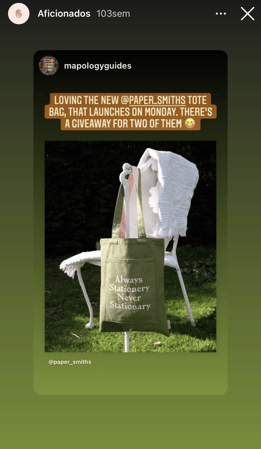
4. Helps establish a back catalog of your brand’s reputation
While having consumer-generated content is unquestionably valuable for marketing campaigns, UGC’s greatest benefit lies in the fact that it functions as proof of your brand’s reputation online.
That’s exactly why you should be extra careful when storing this content.
Papersmiths, the brand we just mentioned above, does a great job of highlighting relevant user-generated content on their Instagram. The “Aficionados” highlight is solely dedicated to Stories published by followers and customers that were later reposted by the brand.
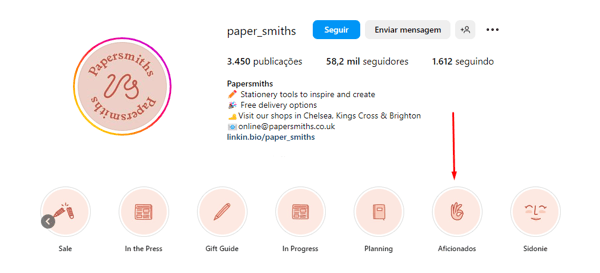
Some examples of user-generated content
As we mentioned earlier, the most common examples of user-generated content are usually confined to Instagram Stories and replying to followers on social media.
It’s highly likely that you’ve already encountered this type of content on a social media platform: Maybe you saw a brand that you like reposting Stories from their customers, or maybe you’ve seen a Facebook post like the one below, where stationery brand Rifle Paper Co. acknowledged and replied their customers:
While these are good examples of how a brand can harness the power of user-generated content, it’s always worth thinking outside the box―not least because your customers and followers do not engage with you solely via Stories and comments.
Below you’ll find a couple of user-generated content examples that are not your run-of-the-mill. Check it out!
🤓 If you are interested in learning more about social media platforms, check out the posts below:
- TikTok Ads Manager: A Guide to Advertising on TikTok
- Writing the Perfect Instagram Bio to Attract Followers
- Quick Guide: Get Ready To Sell On Social Media!
- How Facebook Shops Can Help Your Ecommerce Business
Tutorials or review videos
While platforms like TikTok and YouTube are great places to help you boost sales, they’re also filled with users that create content for themselves and their followers. And there’s a high chance these users have already created or will create reviews and tutorial videos where they rate your product and show their followers and friends how to use it.
⚠️ Mind you, this is not influencer marketing we’re talking about, because you're not paying an influencer to review your products. To make the distinction clear, let’s go over two TikToks posted by the same person: the amazing makeup artist Erin Parsons.
The first TikTok shows a paid partnership between Erin and Dickinson’s Witch Hazel makeup remover. We know it’s paid because it’s explicitly mentioned in the captions, so we know that the artist has officially partnered with the brand.
@erinparsonsmakeup @DickinsonsWitchHazel is my favorite Makeup Remover - it's gentle, not greasy, 100% natural yet it removes waterproof makeup 🤯 #NationalWitchHazelDay #DickinsonsWitchHazel #PurePowerPureYou ♬ original sound - Erin Parsons
Now check out this other TikTok, where Erin is replying to some of her followers’ questions. She’s spontaneously recommending different beauty products, and none of these are paid advertisements.
@erinparsonsmakeup Makeup Artist Secrets Revealed ✨ although I prefer beauty history over sharing products I did want to answer some questions from yesterday :) #mascarahacks #falselashes #lashgate @Mikayla Nogueira #mikaylanogueira ♬ original sound - Erin Parsons
Notice how different they are? This last one is a great example of user-generated content because Erin is sharing products that she’s excited about and that she uses on a daily basis, either professionally or in her private life.
🤓 User-generated content examples: a little YouTube bonus
Burt’s Bees has one of the best user-generated content examples for entrepreneurs who are thinking about using UGC in their marketing strategy.
Just a while ago, the brand posted multiple videos for skincare routines with different women, and they all serve the double purpose of (i) advertising the brand’s products and (ii) positioning Burt’s Bees as an expert in skincare.
Written reviews
User-generated content is not just about pretty pictures and videos: It also involves some two or three lines of text, since happy customers and brand advocates express their admiration with words, too.
And while it’s great to have visual content for your brand’s social media, you shouldn’t neglect your shop’s website―not least because it’s a space with great potential for displaying user-generated content.
Stationery brand Ola provides one of the best user-generated content examples in that department. Their landing page boasts some nice reviews that do a great job of warming the visitor to make a purchase.
You can see that, even though there are no visuals attached to the text, this UGC is still pretty powerful because it comes across as sincere and organic:

Questions about the brand
Your website is the “cornerstone” of your business and helps establish your brand’s presence online. This is why you shouldn’t overlook your About Us page, the Refund and Exchange policies and, perhaps more importantly, your FAQ page.
The FAQ is among the top pages an online store should have because it’s usually the place customers and visitors go to when they run into an unexpected situation, or even when they just want to know a bit more about the brand’s products so they can make an informed shopping decision.
It’s also a great place to apply specific user-generated content, like the jewelry brand Catbird did. Their FAQ draws inspiration from the questions customers have already asked on social media or during a customer service session, and they’re even worded as though the person who’s asking is the actual visitor.
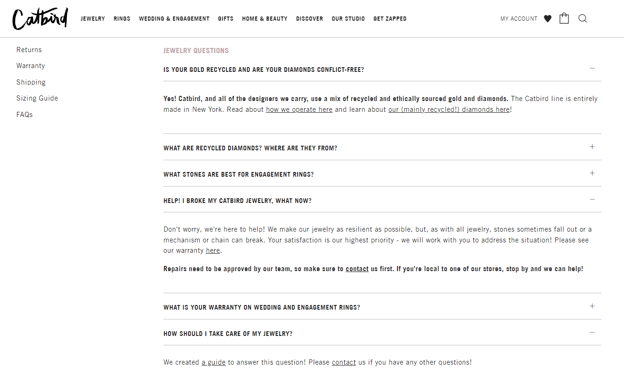
💍 Want to start your own jewelry brand? Here’s everything you need to know to sell jewelry online.
How to encourage customers to create UGC?
By now you’re probably thinking that user-generated content is a powerful content marketing strategy for your business and you’re eager to get this started.
But… How exactly should you go about it? It’s nice to have some user-content generated examples to illustrate the point, but it always looks easier when you see someone else doing it, right?
Fear not, because there are a couple of things you can do to create some valuable user-generated content with your followers. Below are five suggestions to get you started.
Engage with them on social media
Again, let’s circle back to a word that popped up a lot in this article: engagement.
Here’s the thing: If you don’t give your followers any incentives for them to connect with your brand, you won’t have any UGC to collect. That’s why creating opportunities to engage with your target audience should be the first thing on your to-do list.
You can start conversations directly on the social platforms your following is most active on, and those conversations don’t necessarily have to be around products or sales.
In fact, a great way to engage with followers is to open up the question sticker on your Instagram Stories and then take your time with the replies. You can even create a dedicated Highlight for the most popular questions and pin them to your profile so new followers can have a taste of how the brand interacts with customers.
Ola provides a great example of user-generated content done right with the question sticker. You can see how the brand took a question about how the brand started and developed some really nice storytelling about the beginnings of their entrepreneurial journey.
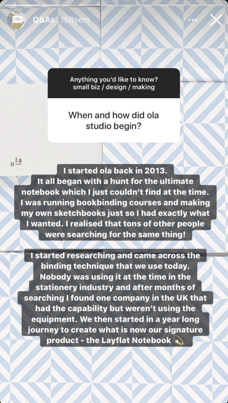
Offer free giveaways or discount codes
Nothing catches the eye of social media followers quite like free giveaways or discount codes for a purchase. So why not use that to spread the word about your brand and get your followers to start creating UGC?
One of the best ways to go about this is to make a special giveaway contest directly on your brand’s social media. You can set up small but important prerequisites―for instance, following the brand’s profile and leaving a comment on the post―and then ask them to post on social media to enter the giveaway.
Ideally, a giveaway like this should last for at least a week so that enough people can participate.
Acknowledge the good and the bad, too
Your customers and followers won’t always be happy with your brand. They also won’t be polite all the time, and while that does suck, it doesn’t mean that you’re allowed to be rude to them or simply ignore their comments.
In fact, even those negative comments can be seen as user-generated content if you’re savvy enough to turn the negative into a positive.
TOMS’s Instagram account is a masterclass on how to use customer objections in your favor. The example of user-generated content below shows how the brand was able to convert a comment that some might interpret as rude into a thorough and thoughtful reply about how their pricing works―and where people can buy their products if they’re located in the US.
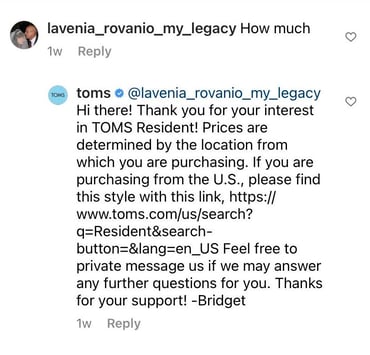
Use branded hashtags
TikTok and Instagram rely heavily on hashtags, which allow users to search for specific content in an organic and seamless way. Hashtags also help bundle a lot of similar content together, whether they’re from the same creators or not.
And guess what: The fact that hashtags do all of that can work in your favor, especially if you use branded hashtags, exclusive hashtags that you create for your brand. The idea is that you encourage followers and customers to post their own user-generated content about the brand and then tag that content with both the brand’s Instagram handle and the branded hashtag.
This will allow you to have a UGC catalog right in the palm of your hand. Pretty neat, right?
Create a memorable unboxing experience
Unboxing is the type of experience that just screams to be turned into UGC. When done right, it has the power to wow customers and get them all excited to show off their new purchases on social media.
Once again our example of user-generated content comes from Papersmiths, who has quite a few UGC from their customers’ unboxing experiences. Their packages come with special cards, cute details and special wrapping paper―all of which connect with their branding as a whole.
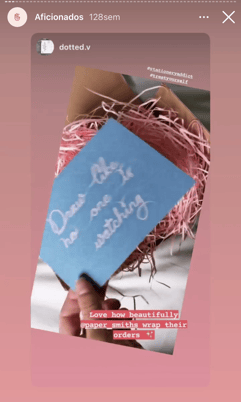
Some tips for collecting and sharing user-generated content
Before you go off on your user-generated content journey, we wanted to leave you with some special tips to make sure everything goes as smoothly as planned.
Always get permission
Just because people are tagging you on their photos doesn’t mean that you have the green light to republish that content on your brand’s social media. In fact, you have to explicitly reach out to those people and ask for their permission to do that.
There are plenty of ways to make it happen, but the more efficient ones are either reaching out to people via DM or just straight up commenting on their posts.
Automate emails for the after-sale
Most user-generated content is created after a customer makes a purchase and receives a package at home, so it’s crucial that you start requesting UGC from your customers around the time the item is shipped to them.
To do that, you can create automated email campaigns to request feedback. Try sending a first email asking them if everything went ok with the delivery and if they are happy with the product. And then, on a second message, ask them if they’d be willing to share a customer review to be featured live on the product page.
🤑 You can pair this second message with a limited-time offer to make the proposition more appealing to them.
Repurpose UGC for different online platforms
When it comes to publicizing user-generated content, handling it on multiple platforms is usually the best way to go―especially if you’re dealing with content that can be repurposed to fit different platforms, like Instagram, TikTok and YouTube.
In the example of user-generated content below, Grown Alchemist has repurposed an Instagram video made by a customer and posted it on their TikTok:
@grownalchemist @adr.santiago1 ♬ if u use this sound ur automatically hot - 🎸
It takes two to UGC
User-generated content can be a powerful ally for brands that are interested in fostering organic relationships with their audience. By interacting and engaging with people, you’re actively showing them that your brand is not just about money and profit but about genuine relationships, too.
In the long run, UGC is also a strategy to build brand loyalty and increase word-of-mouth marketing, because it’ll get more and more people talking about your brand.



